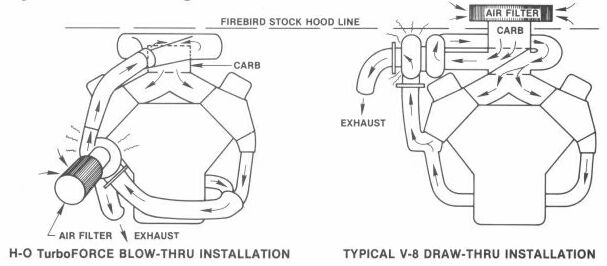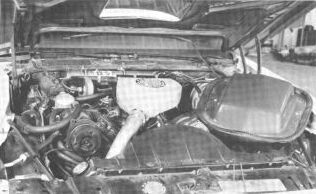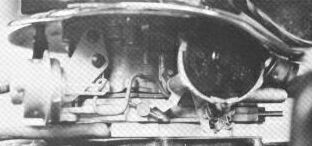
Why Blow Through The Carb?, page 27 text


The acknowledged advantages of blowing through the carburetor:
- There is no "turbo lag" which means that you get instantaneous power when you stop on the throttle.
- No relocation of the carburetor and its associated linkage, fuel line, vacuum hoses, emission controls, etc. Relocating the carb and its associated parts can present tremendous installation problems in draw-through configurations. This avoided with TurboFORCE.
- Turbocharger inlet pressure is always at atmospheric (not throttled) level so maximum capacity is always available>
- Fuel pressure at the carburetor or air box inlet must always be above the boost pressure, otherwise the fuel cannot enter the carburetor. This is solved in the H-O TurboFORCE b using a pressure-compensated mechanical fuel pump which will always provide fuel at seven psi above boost pressure if adequate fuel is delivered to the pump inlet. a [defunct P/N] electric fuel pump is also supplied to assure adequate fuel delivery. It is installed by the gas tank to act as a pusher pump.
- The carburetor must be sealed, inclosed, or pressure compensated to prevent air/fuel mix from leaking out during boost. The special H-O TurboFORCE air bonnet pressurizes the air horn ring and bowl vent directly. It bolts on similar to an air cleaner and does not enclose the carb. The throttle shafts are pressurized by a balance plate installed between the carb and manifold. The accelerator pump shaft is seated with a special Viton o-ring assembly. The choke is pressure balanced from the air bonnet.

Other considerations are:
- The carburetor float must be nitrofil material, not hollow brass. All QJets already use a nitrofil float.
- The PCV line at the valve cover must be moved to the inlet side of the turbocharger. The turbocharger used in H-O TurboFORCE has this provision.
- Fuel evap and some other lines must have check valves and these are provided in the H-O TurboFORCE package.